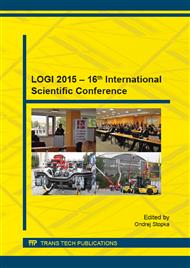[1]
N. Liberto, Powder Coating Overview, In: Powder Coating, Vol. 25, No. 6 (2014) 22-30.
Google Scholar
[2]
D.A. Stanssens, A.J. Van de Werff, L. Molhoek, R. Van der Berg Jeths, Developments on New Complete Binder For Powder Coatings, In: Waterborne, Higher-Solids, and Powder Coatings Symposium, New Orleans, 1994, p.653.
Google Scholar
[3]
S.M. Mirabedini, A. Kiamanesh, The Effect of Micro and Nano-sized Particles on Mechanical and Adhesion Properties of a Clear Polyester Powder Coating, In: Progress in Organic Coatings, Vol. 76, No. 11 (2013).
DOI: 10.1016/j.porgcoat.2013.07.009
Google Scholar
[4]
E. Dogan, A.E. Acar, The Use of Anhydride Linkages to Increase the Glass Transition Temperatures of Polymers Containing Carboxyl End Groups: A Perspective in Powder Coatings, in: Progress in Organic Coatings, Vol. 76, No. 2-3 (2013) 513-518.
DOI: 10.1016/j.porgcoat.2012.11.007
Google Scholar
[5]
M. Barletta, A. Gisario, G. Rubino, Scratch Response of High-Performance Thermoset and Thermoplastic Powders, Deposited by the Electrostatic Spray and Hot Dipping, Fluidized Bed Coating Methods: The Role of the Contact Condition, In: Surface and Coatings Technology, Vol. 205, No. 21-22 (2011).
DOI: 10.1016/j.surfcoat.2011.05.032
Google Scholar
[6]
R. Talbert, Fundamentals of Powder Coating: Equipment and Process Advances Drive Applications, In: Columnist from Products Finishing Magazine, (2011).
Google Scholar
[7]
T.A. Misev, Powder Coatings: Chemistry and Technology, In: R&D Uranox Seminar, Amsterdam, (1996).
Google Scholar
[8]
G.J. Bocchi, Powder Coating Overview: North American Market Overview, In: Powder Coating ´90 Conference Proceedings, Cincinnati: Gardner Publications, Vol. 1 (1990) 1-17.
Google Scholar
[9]
D. Mitchell, The Importance of Preventive Maintenance, In: E-Coating: The Benefits of a Two-Coat Systems, Business News Publishing Company, (2013).
Google Scholar
[10]
R. van der Linde, Resin Composition and Process for the Preparation of this Resin Composition, Patent: 4694033. ep. 228, 116. (1986).
Google Scholar
[11]
J. Hale, Strengthening a Powder Coating Line, in: Products Finishing Magazine, Gardner Business Media: Cincinnati, Ohio, (2013).
Google Scholar
[12]
R. Kampf, J. Gasparik, N. Kudlackova, Application of different forms of transport in relation to the process of transport user value creation, In: Periodica Polytechnica Transportation Engineering, Vol. 40, No. 2 (2012) 71-75.
DOI: 10.3311/pp.tr.2012-2.05
Google Scholar
[13]
G. Fedorko, Z. Cujan, Optimization in modern business practice, In: Int. Conf. Ind. Logist. ICIL 2014 - Conf. Proc., 2014, pp.167-175.
Google Scholar
[14]
G. Fedorko, N. Husakova, G. Dudas, Design of allocation of new technological equipment within the frame of production process in company Getrag Ford Transmissions Slovakia, s. r. o , In: Acta Montan. Slovaca, Vol. 15 (2010) 14-22.
Google Scholar
[15]
V. Molnar, SAP warehouse management system for a warehouse of auxiliary material in the selected company, in: Carpathian Logist. Congr., TANGER LTD, Ostrava, Czech Republic, 2012, pp.1-6.
Google Scholar
[16]
S. Krile, D. Zagar, G. Martinovic, Better Bandwidth Utilization of Multiple Link Capacities with Mutual Traffic Correlation, In: Tehnicki vjesnik - Technical Gazette, Vol. 16, No. 4 (2009) 11-18.
Google Scholar
[17]
P. Prusa, D. Tilkeridis, Possibilities of Logistics Policy Improvement, In: Promet - Traffic & Transportation, Vol. 21, No. 21 (2009) 123-127.
DOI: 10.7307/ptt.v21i2.218
Google Scholar


